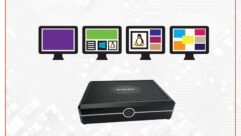
Security Watch: Remote Control
Jun 1, 2004 12:00 PM,
By Bret Bass
Pelco remote monitoring kit
Some security veterans and insiders describe the industry as a fickle beast, an unpredictable force that grows or stalls dramatically and changes its shape into something uncomfortably new and alien every few years. But the security industry never seems that capricious. It grows, the players change, and the technology improves, but much of the security industry remains static.
Each year the same products and services generally lead in the market studies, the industry revenues increase or stay the same, and the hot item seems to be a reworked version of a product that never garnered much popularity in its day. Although the popularity of certain products and services waxes or wanes, their positions of dominance remain roughly the same. For example, burglary and fire products consistently top the list.
Consider last year’s industry trade shows and the attention paid to digital video recording and transmission devices — the products were new but not the concepts. Video surveillance systems have been around for years, but what makes them more appealing now? They can be monitored remotely by the user or by an off-site central station.
The one thing that is always evolving is the one element most people see as constant: monitoring. Despite its potential for increased revenues, monitoring is often overlooked. Systems integrators have yet to fully enter the recurring revenue stream available to them through remote monitoring.
A BRIEF HISTORY OF TIME
The late 1990s were benchmark years. The industry enjoyed tremendous growth, with revenues soaring beyond the $18 billion mark by 2000. The average price of a traditional residential security system was at a six-year high between 1998 and 1999. During that time, the smaller independent dealers still made up the bulk of the sector, but acquisitions by the larger corporations were growing. According to studies, security firms with annual revenues in excess of $1 million effected 60 percent of the acquisitions. By the end of 1998, more than 38 percent of security installers belonged to a corporate dealer program, sponsored by firms such as ADT. Interestingly, monitoring generated $2.8 billion in revenues, though less than 70 percent of security firms actually offered it.
Growth depended on the health of the economy, and new challenges and threats arose. Construction had been strong through 1999 but leveled off by 2000, when new housing construction declined by 7.5 percent, which negatively affected security installers targeting those developments. Offshore competition from Sweden, Japan, and Great Britain became more aggressive. Crime continued to decrease, and the larger security firms began mass-marketing more cookie-cutter security systems, driving the average installation costs down, which made it increasingly difficult for independent alarm installers and systems integrators to compete. Monitoring revenues remained solid, however, and monitoring companies began introducing more specialized services, such as two-way voice verification and rudimentary video verification.
Monitoring comprises a healthy slice of industry revenue.

Then 9/11 happened. The most significant development during this period occurred with systems integrators. As independent firms realized the need to diversify to survive and compete, systems integrators in niche markets gained more prominence, specifically with video surveillance and access control systems installations. After the attacks, consumers began demanding high-end security solutions involving more video surveillance and access control. Technology became the focus, and systems integrators were more qualified to satisfy those demands than traditional alarm installers. Consumers also perceived an increased need for remote monitoring.
By 2002 video surveillance products comprised 15 percent of the industry totals, tied with fire systems for second place behind burglary systems. Remote monitoring services saw a 6 percent increase and generated $5.2 billion in revenue. Today monitoring and video surveillance systems make up more than 40 percent of all revenues in the sector.
MONITORING
Without some sort of monitoring environment, security systems are noisy deterrents. Nearly all monitoring today can be handled by a remote station anywhere in the world, thanks to advances in telephony, network, and Internet technologies. Since 9/11 monitoring companies are quickly restructuring their services to accommodate the new technologies. Integrators who install such systems are more in demand, but few of them consider monitoring. What they are missing out on is a steady stream of monthly recurring revenue.
Traditionally, systems integrators have avoided monitoring because it has always been tailored for the standard alarm installer. In the age of dealer programs, mass-marketed security systems, and low-cost monitoring, integrators receive little benefit from monitoring, because the typical customer wants something cheap and simple. Systems integrators who install high-end and complex systems are beyond the budget of the ADT-type consumer. However, that is changing. Consumers are now willing to spend more for these systems, and they want monitoring. Alarm installers will continue to market to their familiar base, which means that they still shy away from the expensive installs. Their customers won’t pay more than $30 a month in monitoring. But when I was vice president of a specialized video-monitoring company, the calls from customers who wanted something more, regardless of cost, astounded me. When faced with customers who want something more, regardless of the cost, alarm installers will hesitate, but systems integrators will jump at the jobs.
For those integrators, the increased volume of business was a good thing. But what happened between jobs? Nothing. With monitoring revenues, however, the systems integrators were receiving monthly checks to bolster their profit margins and stability between installations.
CONTRACT MONITORING
Amount of industry revenue by type of system/equipment installation.

Contract monitoring requires no participation in a dealer program. You own the accounts, they are your customers, and you provide all the installation and maintenance. The monitoring station is merely subcontracted by you to monitor the systems of your customers. Large contract stations such as NACC in Irvine, California, even offer dealer funding programs, monitor all types of security and a variety of video systems, and offer equipment funding, as well. Typically, contract stations charge about $4 to $10 monthly per account to the dealer, who must then mark up the monitoring fee to the customer. When you consider that the average monthly monitoring fee is about $24, dealers are making a profit of about $19 a month per account. Many contract stations even have interactive software platforms that let dealers and customers access their accounts from the Internet to perform data entry functions, test systems, view account activity, and much more. The benefits of contract monitoring come in terms of control; the station responds to your customers in your company name, following your instructions, and you own the accounts.However, there are some cons to consider. With a contract station, an outside party directly interfaces with your valued customers under your company name. Essentially, it acts as an agent of your organization. If an account is handled improperly or if the level of customer service falls below your standards, the consumer attributes the problems to you, not usually aware that another company is monitoring his or her systems. Some contract stations are not equipped to handle all types of equipment, especially video and access control. If you are committed to a particular product that the station does not support, you must find another company. Some contract monitoring companies can be proprietary in the equipment they support.Perhaps the biggest concern for integrators considering contract stations is price. Stations that monitor video may charge quite a bit for the service. Video monitoring can be labor intensive. Many of the monitoring companies prefer simple and standard verification services that do not satisfy your needs. In this case, video monitoring occurs as a result of an event-generated alarm. They may charge anywhere from $70 to $150 a month per account for video monitoring. Additional services, such as scheduled video patrol tours, cost extra. Continuous monitoring may actually cost you as much as $2 a minute. Many customers are willing to pay that much in video monitoring without question, but these fees are yours. In order to make a profit, you must then mark them up to your customer, which may become a deal breaker.DEALER PROGRAMSCompanies such as ADT and Brinks offer a lot of benefits to participating dealers, but many systems integrators hesitate because of the loss of account ownership. Dealer programs target independent dealers and integrators, allowing them to team up with a large security corporation. In the program, you have access to support services such as sales and marketing support. You can also receive capital funding and revenue sharing. Although you are not selling your company, you are basically selling your accounts. The company offering the dealer program will hold the paper on your customers’ accounts, but you receive a substantial multiple for each account sold. You also receive a percentage of the recurring revenue.One of the biggest downsides to the program is that no long-term equity is being built. The recurring revenue you do receive is significantly less than you would at a contract station. Also, you are required to use only the equipment that the monitoring company has branded. You will also become an “ABC Company Authorized Dealer” to your customers. Although some integrators harbor concerns about how a monitoring station will represent them to their customers, contract stations provide you more control by far. Once your accounts are sold to a dealer program, you have little choice in how they are handled.DO IT YOURSELFMost integrators scoff at this notion, despite the fact that it is most attractive in theory: complete control over the accounts and the profits. But starting a local monitoring company doesn’t have to cost an arm and a leg. For about $50,000, a company can have a fully operational, four-station monitoring center complete with all customized policies and procedures provided, all equipment, and automation software that includes its own billing module. The benefits are that you retain complete control over each customer, and you keep the monthly profits. Areas of concern in this situation come in the forms of the initial up-front costs and the overhead of maintaining the monitoring facility.STEADY AS SHE GOESAn integrator must consider the choice of a monitoring company carefully, but there are benefits to be had. Living from project to project is similar to working in construction — you have good months and bad months. But with monitoring, the peace of mind lies in knowing that during those bad months, you will still find a check in the mail.Bret Bassis a security industry consultant.










